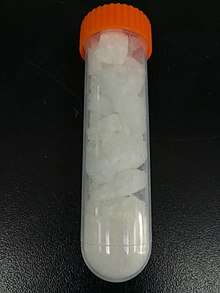Yttrium(III) nitrate
Yttrium(III) nitrate is an inorganic compound with the formula Y(NO3)3. The hexahydrate is the most common form commercially available.
 | |
| Names | |
|---|---|
| Other names
Yttrium nitrate | |
| Identifiers | |
| |
3D model (JSmol) |
|
| ECHA InfoCard | 100.030.717 |
| EC Number |
|
PubChem CID |
|
| UNII |
|
CompTox Dashboard (EPA) |
|
| |
| |
| Properties | |
| Y(NO3)3 | |
| Molar mass | 274.927 |
| Appearance | Colorless crystals |
| Soluble | |
Except where otherwise noted, data are given for materials in their standard state (at 25 °C [77 °F], 100 kPa). | |
| Infobox references | |
Preparation
Yttrium(III) nitrate can be prepared by dissolving corresponding metal oxide in 6 mol/L nitric acid:[1]
- Y2O3 + 6 HNO3 → 2 Y(NO3)3 + 3 H2O
Properties
Yttrium(III) nitrate hexahydrate loses crystallized water at relatively low temperature. Upon further heating, basic salt YONO3 is formed.[2] At 600 C, the thermal decomposition is complete. Y2O3 is the final product.[3]
Y(NO3)3·3TBP is formed when tributyl phophate is used as the extracting solvent.[4]
Uses
Yttrium(III) nitrate mainly uses as a source of Y3+ cation. It is a precursor of some yttrium-containing materials, such as Y4Al2O9,[3] YBa2Cu3O6.5+x[2] and yttrium-based metal-organic frameworks. [5] It can also be used as a catalyst in organic synthesis.[6]
References
- Dong, Bin; Hua, Rui N.; Cao, Bao S.; Li, Zhi P.; He, Yang Y.; Zhang, Zhen Y.; Wolfbeis, Otto S. (2014). "Size dependence of the upconverted luminescence of NaYF4:Er,Yb microspheres for use in ratiometric thermometry". Physical Chemistry Chemical Physics. 16 (37): 20009. doi:10.1039/C4CP01966K. ISSN 1463-9076.
- Zhuang, R.F.; Qiu, J.B.; Zhu, Y.P. (1990). "A study on reaction mechanism in preparation of Y-Ba-Cu-O superconducting material from the thermoreaction method of nitrates". Journal of Solid State Chemistry. 86 (1): 125–128. doi:10.1016/0022-4596(90)90122-E. ISSN 0022-4596.
- Xu, F.M.; Zhang, Z.J.; Shi, X.L.; Tan, Y.; Yang, J.M. (2011). "Effects of adding yttrium nitrate on the mechanical properties of hot-pressed AlN ceramics". Journal of Alloys and Compounds. 509 (35): 8688–8691. doi:10.1016/j.jallcom.2011.05.110. ISSN 0925-8388.
- Scargill, D.; Alcock, K.; Fletcher, J.M.; Hesford, E.; McKay, H.A.C. (1957). "Tri-n-butyl phosphate as an extracting solvent for inorganic nitrates—II Yttrium and the lower lanthanide nitrates". Journal of Inorganic and Nuclear Chemistry. 4 (5–6): 304–314. doi:10.1016/0022-1902(57)80012-8. ISSN 0022-1902.
- Duan, Tian-Wei; Yan, Bing (2014). "Hybrids based on lanthanide ions activated yttrium metal–organic frameworks: functional assembly, polymer film preparation and luminescence tuning". J. Mater. Chem. C. 2 (26): 5098–5104. doi:10.1039/C4TC00414K. ISSN 2050-7526.
- Bhanushali, Mayur J.; Nandurkar, Nitin S.; Jagtap, Sachin R.; Bhanage, Bhalchandra M. (2008). "Y(NO3)3·6H2O catalyzed aza-Michael addition of aromatic/hetero-aromatic amines under solvent-free conditions". Catalysis Communications. 9 (6): 1189–1195. doi:10.1016/j.catcom.2007.11.002. ISSN 1566-7367.
| HNO3 | He | ||||||||||||||||
| LiNO3 | Be(NO3)2 | B(NO 3)− 4 |
RONO2 | NO− 3 NH4NO3 |
HOONO2 | FNO3 | Ne | ||||||||||
| NaNO3 | Mg(NO3)2 | Al(NO3)3 | Si | P | S | ClONO2 | Ar | ||||||||||
| KNO3 | Ca(NO3)2 | Sc(NO3)3 | Ti(NO3)4 | VO(NO3)3 | Cr(NO3)3 | Mn(NO3)2 | Fe(NO3)2 Fe(NO3)3 |
Co(NO3)2 Co(NO3)3 |
Ni(NO3)2 | CuNO3 Cu(NO3)2 |
Zn(NO3)2 | Ga(NO3)3 | Ge | As | Se | Br | Kr |
| RbNO3 | Sr(NO3)2 | Y(NO3)3 | Zr(NO3)4 | Nb | Mo | Tc | Ru(NO3)3 | Rh(NO3)3 | Pd(NO3)2 Pd(NO3)4 |
AgNO3 Ag(NO3)2 |
Cd(NO3)2 | In | Sn | Sb(NO3)3 | Te | I | Xe(NO3)2 |
| CsNO3 | Ba(NO3)2 | Hf | Ta | W | Re | Os | Ir | Pt(NO3)2 Pt(NO3)4 |
Au(NO3)3 | Hg2(NO3)2 Hg(NO3)2 |
TlNO3 Tl(NO3)3 |
Pb(NO3)2 | Bi(NO3)3 BiO(NO3) |
Po(NO3)4 | At | Rn | |
| FrNO3 | Ra(NO3)2 | Rf | Db | Sg | Bh | Hs | Mt | Ds | Rg | Cn | Nh | Fl | Mc | Lv | Ts | Og | |
| ↓ | |||||||||||||||||
| La(NO3)3 | Ce(NO3)3 Ce(NO3)4 |
Pr(NO3)3 | Nd(NO3)3 | Pm(NO3)3 | Sm(NO3)3 | Eu(NO3)3 | Gd(NO3)3 | Tb(NO3)3 | Dy(NO3)3 | Ho(NO3)3 | Er(NO3)3 | Tm(NO3)3 | Yb(NO3)3 | Lu(NO3)3 | |||
| Ac(NO3)3 | Th(NO3)4 | PaO2(NO3)3 | UO2(NO3)2 | Np(NO3)4 | Pu(NO3)4 | Am(NO3)3 | Cm(NO3)3 | Bk | Cf | Es | Fm | Md | No | Lr | |||